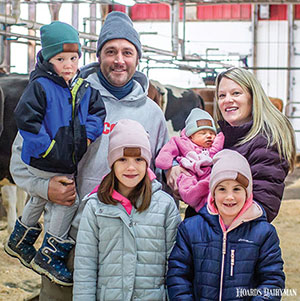

We asked four farms that question, and as one might expect, their answers were all unique. For Benthem Brothers Dairy in McBain, Mich., they would add a digester to capture methane from manure on their 3,000-cow dairy. “We think this will help us reach our sustainability goals,” said Ryan Benthem, one of the farm’s owners.

“I would add more help,” was the response given by Jimmy Harris, who milks 80 cows on his Darkhorse Farm near Perkasie, Pa. “I would love to be able to walk out to the barn and spend more time with my kids, doing things on the farm together like fishing, halter breaking a show heifer, and riding four-wheelers.” They have some part-time help to assist with their dairy and hay making business, but the opportunity to spend more time with his four young children while not working is on Harris’ wish list.

At Hillside Dairy near Fallon, Nev., they would focus on maintenance and efficiency. Eric Olsen, who owns the dairy with his brothers Neil and Pete, said, “I would rotate and replace equipment sooner.” Other investments would include more cropland, because he said that is always useful to have, and possibly a rotary parlor to enhance milking efficiency. They currently milk their 2,800 cows in a double-44 parallel parlor.
For the Kaufman family of Porterfield, Wis., improvements to cow comfort in their freestall barn over the years yielded many positive results. Now, there are a few other areas of the operation they would like to update, if possible. “If money was not a problem, we would build a new heifer facility and put in a cement pad for our feed pile,” shared Ben Kaufman, who farms with his wife and parents on their 280-cow dairy.
On the flip side, we also asked the farms if there are products or services they have given up in the last five to 10 years that have not been missed.
Harris said they stopped feeding high-moisture corn after switching to high chopped brown midrib (BMR) corn silage. Now they feed more corn silage and just 7 pounds of dry corn per head to the lactating cows.
Another positive change for them was switching to nearly 100% no-till on their cropland. “Conventional tillage is a practice we don’t miss,” Harris explained. “Cover crops, weed control, soil sampling, and trying to stay off fields in wet conditions have made no-till successful for us.”
At Kaufman Farms, they no longer do Johne’s testing since they rarely found positive cows. They also stopped using Posilac as a requirement from their milk processor, but it ended up reaping positive rewards. “After we quit using it, conception rates went up, somatic cell count went down, and overall herd health improved,” Kaufman said. “The elimination of these two procedures has also reduced our cost of production.”
For Olsen, automated teat dippers helped them improve consistency in their milking routine. “We went away from manual teat dipping, and we are happy with that change. There is no more reminding the milkers to do a better job,” he shared. “Now we always get the same results.”
If you would like to learn more about these farms and the products and services they find most useful, check out the article “They share their best buys and decisions” that appeared in the February issue of Hoard’s Dairyman.








